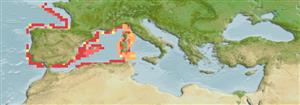Common names from other countries
分类 / Names
俗名 | 同种异名 | Catalog of Fishes(属, 种) | ITIS | CoL | WoRMS | Cloffa
Teleostei >
Ophidiiformes (Cusk eels) >
Bythitidae (Livebearing brotulas)
Etymology: Cataetyx: Greek, kata = down + Greek, etix, stixo, stizo = to prick, to puncture.
Environment: milieu / climate zone / depth range / distribution range
生态学
海洋 深海底的; 深度上下限 480 - 1000 m (Ref. 4758). 深水域; 51°N - 36°N, 10°W - 11°E
Eastern Atlantic: France to Portugal and the Ligurian Sea in the Mediterranean.
東大西洋: 在地中海中的法國到葡萄牙與利古里安海。
Length at first maturity / 大小 / 重量 / 年龄
Maturity: Lm ?, range 10 - ? cm
Max length : 12.0 cm TL 雄鱼/尚未辨别雌雄; (Ref. 4758)
A locally abundant species that feeds on polychaetes and benthic crustaceans (Ref. 34024). Viviparous (Ref. 4758).
一个地方性丰富的种捕食多毛类动物与底栖的甲壳动物。 (参考文献 34024) 胎生的.(参考文献 4758)
Life cycle and mating behavior
Maturities | 繁殖 | Spawnings | Egg(s) | Fecundities | 仔鱼
東大西洋: 在地中海中的法國到葡萄牙與利古里安海。
Nielsen, J.G., D.M. Cohen, D.F. Markle and C.R. Robins, 1999. Ophidiiform fishes of the world (Order Ophidiiformes). An annotated and illustrated catalogue of pearlfishes, cusk-eels, brotulas and other ophidiiform fishes known to date. FAO Fish. Synop. 125(18):178p. Rome: FAO. (Ref. 34024)
CITES (Ref. 128078)
Not Evaluated
人类利用
渔业: 没有兴趣
工具
特别资料
下载 XML
网络资源
Estimates based on models
Preferred temperature (Ref.
115969): 10.7 - 13.7, mean 13.1 (based on 21 cells).
Phylogenetic diversity index (Ref.
82804): PD
50 = 0.5002 [Uniqueness, from 0.5 = low to 2.0 = high].
Bayesian length-weight: a=0.00457 (0.00179 - 0.01169), b=3.10 (2.87 - 3.33), in cm Total Length, based on LWR estimates for this (Sub)family-body shape (Ref.
93245).
营养阶层 (Ref.
69278): 3.4 ±0.48 se; based on food items.
回复力 (Ref.
120179): 中等的, 族群倍增时间最少 1.4 - 4.4年 (Assuming Fec < 1000; K=0.94).
Fishing Vulnerability (Ref.
59153): Low vulnerability (14 of 100).
